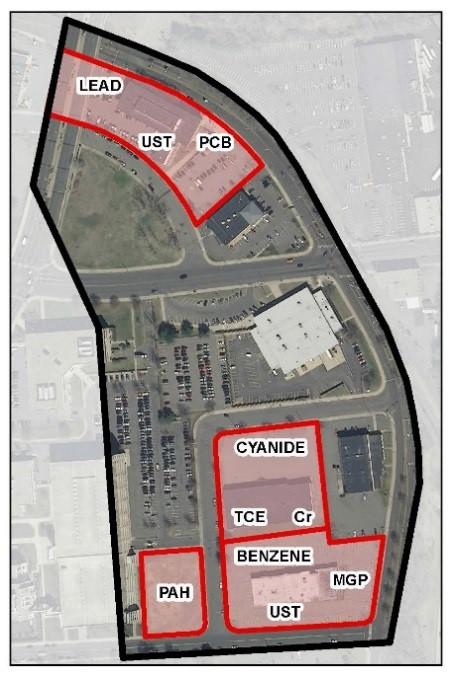City of New Britain, CT Assessment, Remediation and Demolition of Multiple Buildings for Redevelopment
Back to ProjectProject Description
CEI was retained by the City of New Britain to perform various Environmental Assessments, Remediation, Demolition, and Redevelopment of four sites within the downtown TOD development area. The sites included a vacant lot, a former auto dealership, a former tire and auto service center, and a former police facility. Past uses on the sites included a manufactured gas plant (MGP) facility, a plating and manufacturing facility, and a hardware manufacturer (Stanley Tool). In addition to industrial chemical wastes (i.e., chromium, cyanide, TCE), there were also asbestos, polychlorinated biphenyls (PCBs), lead, manufactured gas derivatives, and underground storage tanks (USTs) on some of the sites. Each of the 4 sites had undergone various levels of environmental review varying from none to a preliminary Phase III environmental assessment. Two of the sites were city-owned and two of the sites were privately owned. The private property owners allowed the city to conduct these studies as part of the DECD grant funding.
The site at 1 Bosco Drive historically occupied an electro-plating company, a tire re-capping operation, and a machine shop. The buildings associated with these uses were razed in the 1960s as part of the City of New Britain redevelopment of the area and the site was redeveloped for use as an auto repair and tire shop. Previous studies took the site to Phase II – III investigations with identified contaminants of concern including urban polluted fill containing ash/coal/asphalt/demolition debris, petroleum associated with hydraulic lifts and materials storage, chromium associated with the former electro-plating facility, and TCE associated with the former electro-plating/machining facility. CEI performed supplemental Phase III investigations to identify the potential source of TCE and chromium contamination and to define the extents of petroleum contamination found on the exterior of the auto repair shop building. Hexavalent chromium was discovered in concentrations exceeding the Direct Exposure Criteria (DEC) and Pollutant Mobility Criteria (PMC) in the Connecticut Remediation Standard Regulations (RSRs), as well as the CTDEEP Contained-In Policy outside the building footprint, adjacent to the building foundation. Low concentrations of TCE were found at various locations throughout the site.
The present owner obtained DECD funding for demolition of the building on the property, which was demolished at the tail end of the Phase III Supplemental Investigations. This allowed CEI to collect a limited number of samples beneath the building as part of the Phase III Investigations, which showed a higher concentration TCE source area.
Subsequent to the Phase III investigations, CEI prepared a remedial action plan to remove and/or render the subject materials as environmentally isolated beneath the building. Plans and specifications were developed for the remediation program which was overseen by CEI. The Contractor engaged United Retek to treat the chromium contaminated soils outside the former and proposed building footprint to render them non-hazardous in conformance with CT DEEP’s Contained-In Policy. The chromium contaminated soils were excavated and treated with Portland Cement under United Retek’s State-wide mobile permit. The chromium did not meet GB PMC after treatment and were shipped off-site to a disposal facility.
During the remedial work, it became evident that the TCE and hexavalent chromium contamination was more extensive than originally documented. An extensive sampling program was performed to delineate the extents of contamination to allow the Contractor to excavate and live-load the contamination for off-site disposal and/or treatment. TCE contamination was found at varying depths beneath the building ranging from the surface to 10+ feet. The TCE contamination was excavated to meet GB PMC by mass analysis and/or SPLP analysis. Excavated soils were shipped to an off-site disposal facility and confirmatory samples were collected in the field.
Due to budget constraints, CEI developed alternative scenarios for removal and/or rendering the chromium contaminated soils beneath the building environmentally isolated. Treatment was proposed to eliminate the soils as an ongoing source of chromium contamination to the groundwater, while the site remained undeveloped. Because the chromium contamination was associated with a former plating facility, the work needed to comply with both the Connecticut RSRs and RCRA standards for treatment and land disposal. CEI worked with United Retek to determine alternative treatment options. The goal was to find a treatment that would not only address the leaching of chromium from the soils, but also convert the hexavalent chromium to the less toxic trivalent chromium. After piloting various chemicals and dosage rates, United Retek used ferrous sulfate to achieve treatment goals. The ferrous sulfate treatment successfully reduced the hexavalent chromium levels to meet CT DEEP’s RSRs and Contained-in standards, allowing the soils to be managed as a polluted soil on the site.
CEI also worked with the University of Connecticut (UConn) to evaluate the potential and likelihood for the trivalent chromium to oxidize to hexavalent chromium after treatment. UConn has been involved with several studies pertaining to the treatment and stability of hexavalent chromium. The parameters that facilitate oxidation of chromium are low pH and the presence of sufficient manganese oxides in the soil. UConn environmental staff performed testing of the soils to determine the availability of manganese oxides to convert trivalent chromium to hexavalent chromium under different pHs. The tests showed low oxidation potential, primarily due to the low manganese oxides in the soil.
Other contaminated soils on the site containing lead and low concentrations of petroleum were relocated beneath the future building footprint to render these soils inaccessible.
CEI’s innovative approach provided for on-site treatment of the majority of chromium contaminated soils to meet Connecticut Contained-in standards, RSRs and LDRs, allowing for reburial of the material where it was excavated, which corresponds with the location of a future building. CEI also provided a remedial action report which defined the limits of remaining contamination on the site and how it is to be addressed with future development using an ELUR to render materials inaccessible and environmentally isolated.


